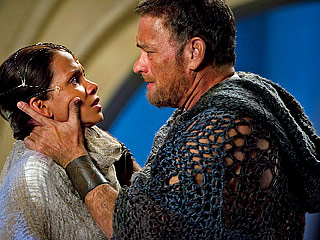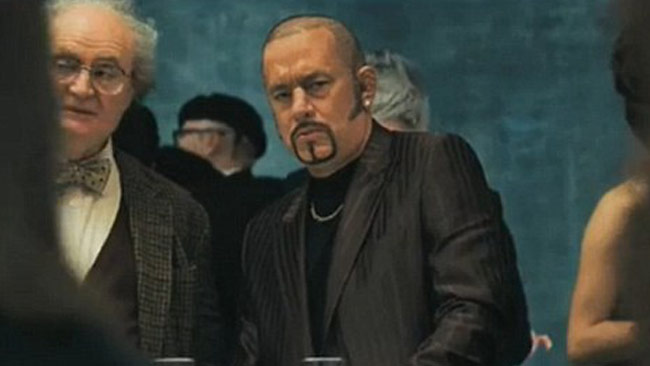Film Review: “Cloud Atlas” — Pushing Cinematic Boundaries
Cloud Atlas is irresistible, a visual and sensory marvel with a winning mix of charm and humor to offset the dark violence and mayhem within the sobering tale.
Cloud Atlas. Directed by Lana and Andy Wachowski and Tom Twyker. At various cinemas throughout New England.
By Glenn Rifkin
Cloud Atlas is one giant, roiling bouillabaisse of a movie. There is so much going on in this remarkable, sci-fi adventure film that one could use a scorecard and a notebook to keep track. Based on the 2004 Man Booker-nominated novel by British author David Mitchell, Cloud Atlas is an epic revelation of ambitious storytelling that tracks more than a dozen characters whose lives become interconnected over a span of 500 years, from the mid-nineteenth century to the distant, post-apocalyptic future, through the mysteries of reincarnation and karma. “Our lives are not our own,” says one of the characters. “From womb to tomb, we are bound to others. From past to present. And with each crime and every kindness, we birth our future.”
The actions and behavior of each character ripple out like the proverbial rings on a pond across the past, present, and future, impacting each other through various incarnations. As the movie’s tagline states, “Everything is connected,” and an act of kindness from the past arcs across the centuries to change the outcome of humanity.
The film’s stars, Tom Hanks, Halle Berry, Jim Broadbent, Hugo Weaving, Susan Sarandon, Hugh Grant, Keith David, Jim Sturgess, and Doona Bae, all play five or six characters, sometimes of different genders and races, and across the span of centuries in a stunning display of both acting prowess and compelling photography, special effects, design, and make-up. Part of the fun is identifying which actor is playing which character, a riddle solved during the end credits, much to the audience’s delight.
At a running time of nearly three hours, Cloud Atlas asks a lot of its audience. But it gives back far more. This is what it means to push the cinematic boundaries. I suspect the reviews and reactions will be mixed. You’ll either love it or hate it. But I found it irresistible, a visual and sensory marvel with a winning mix of charm and humor to offset the dark violence and mayhem within the sobering tale. This is not for the faint of heart. There is enough throat-slitting, skull-crushing blood-letting to satisfy those who prefer that their sci-fi run red. But it is no slasher film either. There is subtlety and a sense of fable: a thoughtful and intellectual take on the notion that we actually don’t go around just once in this life. Written and directed by Tom Tykwer and the Wachowskis, Andy and Lana, the pair of brothers, now brother and sister (more on that later), who created The Matrix, Cloud Atlas seems destined to become a similar cult classic.
It is a bit of a wonder that the filmmakers were able to attract the likes of Oscar winners Berry, Hanks, Broadbent, and Sarandon to this project, but good for them for jumping on board. Hanks, rebounding from 2011’s dismal Larry Crowne, is mesmerizing as Dr. Henry Goose, the dastardly, nineteenth-century ship’s doctor and Zachry, the heroic islander in post-apocalyptic Hawaii, along with several other smaller roles. But it is the under-appreciated Broadbent who steals the film with a set of superb performances that are over the top. His portrayal of the bungling publisher Timothy Cavendish, who becomes inadvertently imprisoned in a nightmarish home for the aged, is hysterically funny and among the movie’s highlights. Emerging Korean star Doona Bae is startling as the futuristic Korean clone/fast food waitress who finds brief freedom, enlightenment, and immortality. The flicker of understanding in her porcelain face is riveting, and her gossamer beauty impossible to ignore.
But most of the credit has to go to Tykwer and the Wachowskis for pulling off this ambitious effort. Adapting Mitchell’s complex, multi-layered novel to the screen was a challenging task. Effectively creating and intertwining six stories that coherently span the centuries is a marvelous and dexterous feat. No sequence lasts more than a few minutes before leaping backwards or forwards in time, from the deck of a nineteenth-century schooner to the manic, video game-like hyper drive of an imagined twenty-second century Seoul. The creative team behind the project—photography directors John Toll and Frank Griebe, production designers Uli Hanisch and Hugh Bateup, editor Alexander Berner, costume designers Kym Barrett and Pierre-Yves Gayraud, and visual effects supervisor Dan Glass—create a visually arresting masterwork. And the music, integral to the plot line and the film’s title, is adroitly composed by Tykwer, Johnny Klimek, and Reinhold Heil. The Cloud Atlas Sextet is the title of a brilliant musical score created by one of the film’s tragic characters.
Having teamed up for The Matrix trilogy, the Wachowski Brothers have not produced much since Speed Racer in 2008. After that film, Larry Wachowski underwent a sex change and is now Lana. Given the monumental impact of The Matrix, it would be hard to imagine a more impressive encore for the Wachowskis. Cloud Atlas is destined to do some serious box office, if for no other reason than filmgoers will undoubtedly feel the need and desire to see it two or three times.


